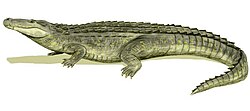| Leidyosuchus Temporal range: Late Cretaceous: Campanian, | |
|---|---|
 | |
| Leidyosuchus canadensis skull | |
| Scientific classification | |
| Domain: | Eukaryota |
| Kingdom: | Animalia |
| Phylum: | Chordata |
| Class: | Reptilia |
| Clade: | Archosauria |
| Order: | Crocodilia |
| Superfamily: | Alligatoroidea |
| Genus: | † Leidyosuchus Lambe, 1907 |
| Species | |
| |
Leidyosuchus (meaning "Leidy's crocodile") is an extinct genus of eusuchian, either an alligatoroid crocodilian or a stem-group crocodilian, from the Late Cretaceous of Alberta. It was named in 1907 by Lawrence Lambe, and the type species is L. canadensis. [2] It is known from a number of specimens from the middle Campanian age Dinosaur Park Formation. It was a medium-sized alligatoroid, with a maximum skull length greater than 40 centimeters (16 in). [3]


A number of species had been assigned to this genus over the years, including: L. acutidentatus (Sternberg, 1932), from the Paleocene of Saskatchewan; L. formidabilis (Erickson, 1976), from the Paleocene of North Dakota and Wyoming; L. gilmorei (Mook, 1942), from the Campanian of Alberta; L. multidentatus (Mook, 1930); L. riggsi (Schmidt, 1938); L. sternbergii (Gilmore, 1910), from the Maastrichtian (Late Cretaceous) of Colorado, Montana, North Dakota, South Dakota, and Wyoming; and L. wilsoni (Mook, 1959), from the Eocene of Wyoming. [3] However, in 1997 Chris Brochu reevaluated the genus and reassigned most of the species, transferring L. acutidentatus, L. formidabilis, L. sternbergii, and L. wilsoni to the new genus Borealosuchus , and L. multidentatus to the new genus Listrognathosuchus , proposing L. gilmorei as a synonym of L. canadensis, and finding L. riggsi to be too fragmentary to be determinable. [3] [4]


